The 1930s marked a revolutionary era in women’s hairstyling, where elegance met practicality in the most sophisticated ways.
As we explore 27 Chic 1930s Short Hairstyles Perfect for Timeless Look, you’ll discover how these vintage styles continue to inspire modern fashion with their graceful waves, sleek finger curls, and perfectly sculpted silhouettes.
This decade introduced iconic looks that Hollywood starlets like Jean Harlow and Greta Garbo made famous, transforming short hair from a bold statement into an art form.
Whether you’re preparing for a themed event, seeking vintage inspiration for your next salon visit, or simply fascinated by the glamorous past, this comprehensive guide will walk you through each distinctive style that defined an era.
From the Marcel wave’s S-shaped perfection to the daring shingle bob, you’ll learn the characteristics, styling techniques, and modern adaptations of these timeless cuts that prove great style never truly goes out of fashion.
Contents
- 1 1. The Classic Marcel Wave
- 2 2. The Finger Wave Bob
- 3 3. The Shingle Bob
- 4 4. The Eton Crop
- 5 5. The Curly Top Bob
- 6 6. The Pageboy Cut
- 7 7. The Pin Curl Set
- 8 8. The Asymmetrical Bob
- 9 9. The Water Wave
- 10 10. The Faux Bob
- 11 11. The Slicked-Back Shingle
- 12 12. The Side-Swept Wave
- 13 13. The Curled Fringe Bob
- 14 14. The Gibson Roll Variation
- 15 15. The Graduated Layer Bob
- 16 16. The Deep Wave Bob
- 17 17. The Brush-Out Wave
- 18 18. The Peek-a-Boo Bob
- 19 19. The Feathered Ends Bob
- 20 20. The Victory Roll Foundation
- 21 21. The Coronet Braid Bob
- 22 22. The Cloche-Friendly Bob
- 23 23. The Sculptured Wave Bob
- 24 24. The Natural Texture Bob
- 25 25. The Tapered Nape Bob
- 26 26. The Crimped Wave Bob
- 27 27. The Evening Glamour Bob
- 28 Styling Tips for Modern Wearers
- 29 Conclusion
1. The Classic Marcel Wave

The Marcel wave stands as the cornerstone of 1930s hairstyling, created using heated curling irons to produce deep, uniform S-shaped waves.
This technique required exceptional skill and remains one of the most recognizable vintage styles today.
- The waves were created by crimping hair between two heated iron blades, producing perfectly symmetrical patterns that framed the face with mathematical precision.
- Professional hairstylists would spend up to an hour creating these waves, ensuring each curve aligned perfectly with the next for a polished, cohesive look.
- The style worked exceptionally well on bob-length hair, typically falling between chin and shoulder length.
- Modern recreations often use flat irons or specialized Marcel iron tools, making the technique more accessible to home stylists.
- Setting lotion or mousse applied to damp hair helps hold the wave pattern throughout the day without the stiffness of heavy hairsprays.
2. The Finger Wave Bob
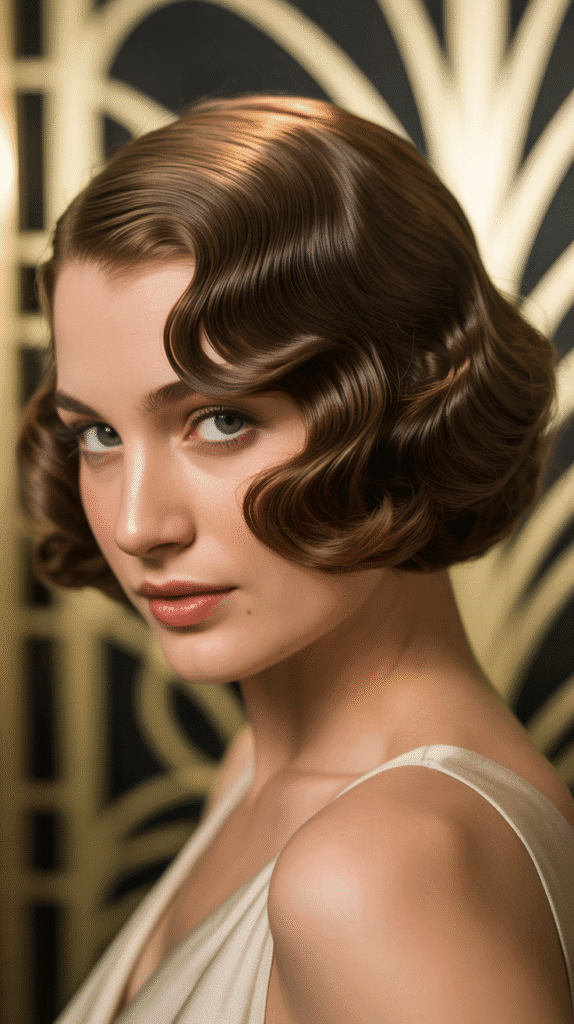
Finger waves represent the artistry of 1930s hairstyling, where stylists literally sculpted hair into waves using only their fingers, combs, and setting gel.
This labor-intensive technique created softer, more fluid waves than the Marcel method.
- The process involved sectioning damp hair and using the index finger to create a ridge while combing the hair in alternating directions.
- Each wave was pinned in place with metal wave clips until completely dry, ensuring the pattern held its shape.
- This style particularly flattered oval and heart-shaped faces, drawing attention to cheekbones and creating an elongating effect.
- Deep side parts were essential to the authentic look, typically positioned above one eyebrow to create dramatic asymmetry.
- The finished style required minimal maintenance but needed to be reset every 3-4 days to maintain its crisp definition.
- Setting gel formulas from the era contained ingredients like flaxseed or quince seed, which modern stylists have replaced with alcohol-free setting lotions.
3. The Shingle Bob
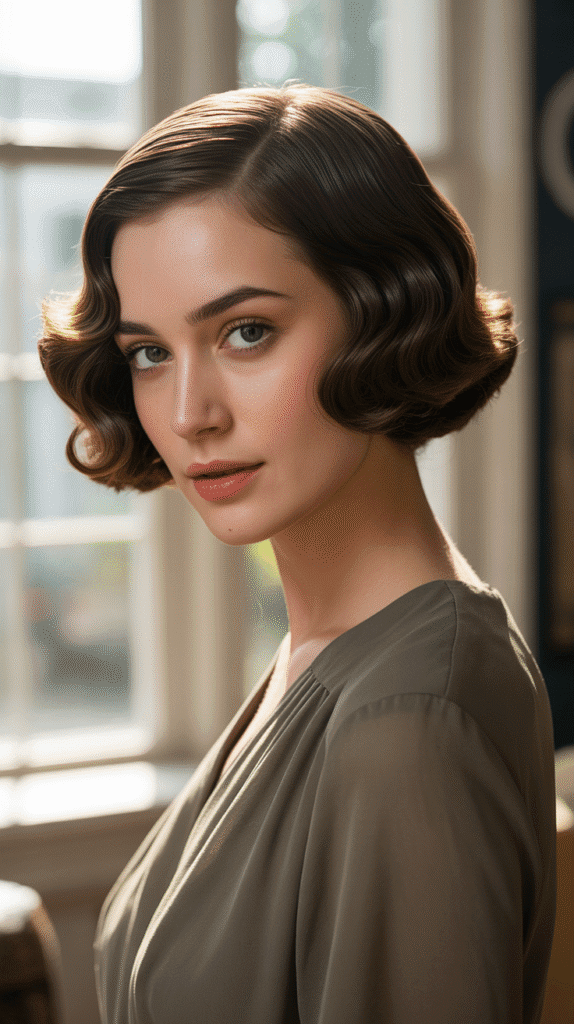
The shingle bob revolutionized women’s hairstyling by introducing a graduated cut that was shorter at the nape and longer toward the face.
This architectural cut required precise barbering skills and created a sleek, tapered silhouette.
- Hairdressers used clippers and razors to create the characteristic V-shape at the nape, a technique borrowed from men’s barbering.
- The style exposed the neck completely, which was considered daringly modern and required confidence to wear.
- Longer sections at the front could be styled into small curls or waves, providing versatility despite the short length.
- This cut worked best on straight to slightly wavy hair textures, as very curly hair obscured the precise lines.
- Regular maintenance every 4-6 weeks was essential to preserve the clean graduation and prevent the back from becoming too bulky.
- The shingle bob influenced contemporary pixie cuts and undercut styles, proving its enduring design relevance.
4. The Eton Crop
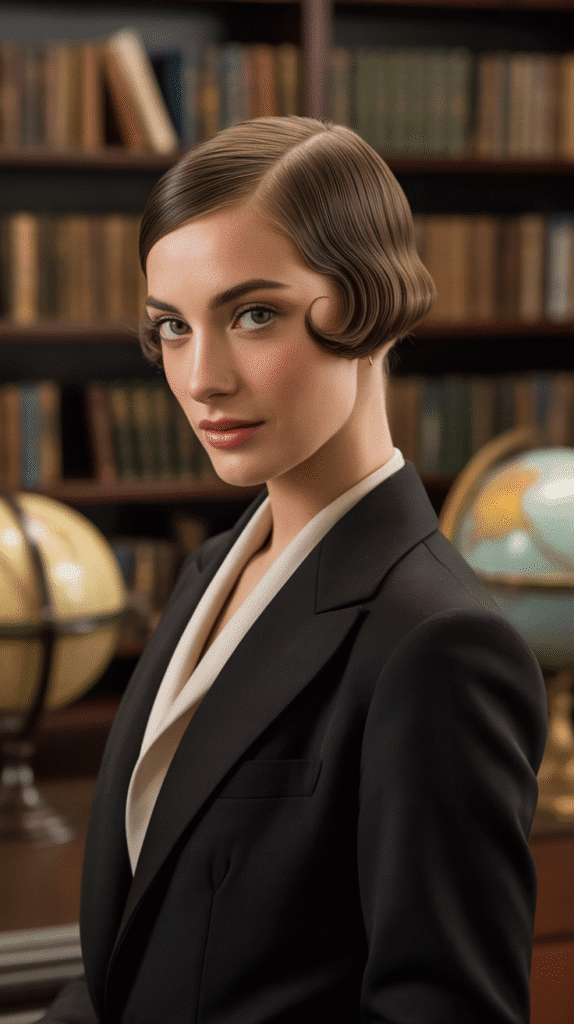
The Eton crop represented the most daring short hairstyle of the 1930s, cut extremely close to the head with masculine precision.
Named after the famous British boys’ school, this style challenged conventional femininity and attracted bold, fashion-forward women.
- The cut typically measured less than two inches all over, with slightly longer sections on top that could be slicked back or styled with small waves.
- This style required an oval or heart-shaped face with delicate features to avoid appearing too severe or masculine.
- Daily styling involved applying pomade or brilliantine to create a sleek, polished surface with a high-gloss shine.
- The Eton crop became associated with intellectuals, artists, and women who embraced androgynous fashion trends.
- Maintenance was relatively simple compared to waved styles, though frequent trims every three weeks were necessary.
- Accessories like jeweled headbands, decorative combs, or small feathered fascinators added feminine touches to this ultra-short style.
5. The Curly Top Bob
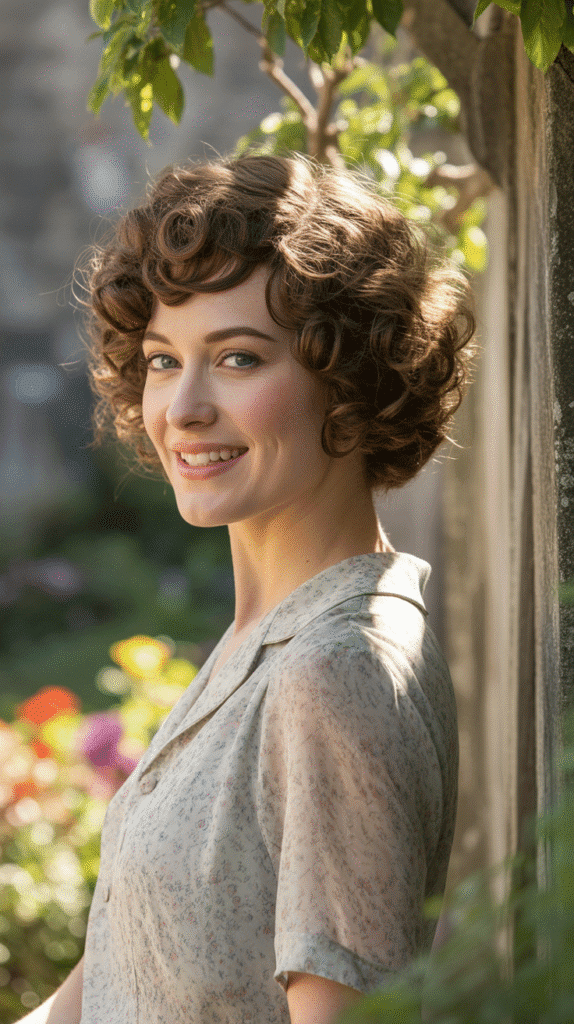
The curly top bob celebrated natural curl patterns while maintaining the structured bob silhouette that defined 1930s style.
This approach allowed women with naturally curly hair to participate in the short hair trend without constant straightening.
- Hair was cut to uniform length, typically between ear and chin level, allowing curls to form a rounded shape around the head.
- Stylists used curl-enhancing creams and pin-curling techniques to define and organize the natural curl pattern into neat, bouncy ringlets.
- The crown area often featured tighter, smaller curls while the sides displayed looser waves for dimensional interest.
- This style required nightly setting on pincurls or rag rollers to maintain the organized curl structure and prevent frizz.
- A center or slight side part worked best, avoiding the dramatic deep parts used in waved styles that could disrupt curl patterns.
- Modern curl creams and diffusing techniques make this style easier to achieve and maintain than in the original era.
6. The Pageboy Cut
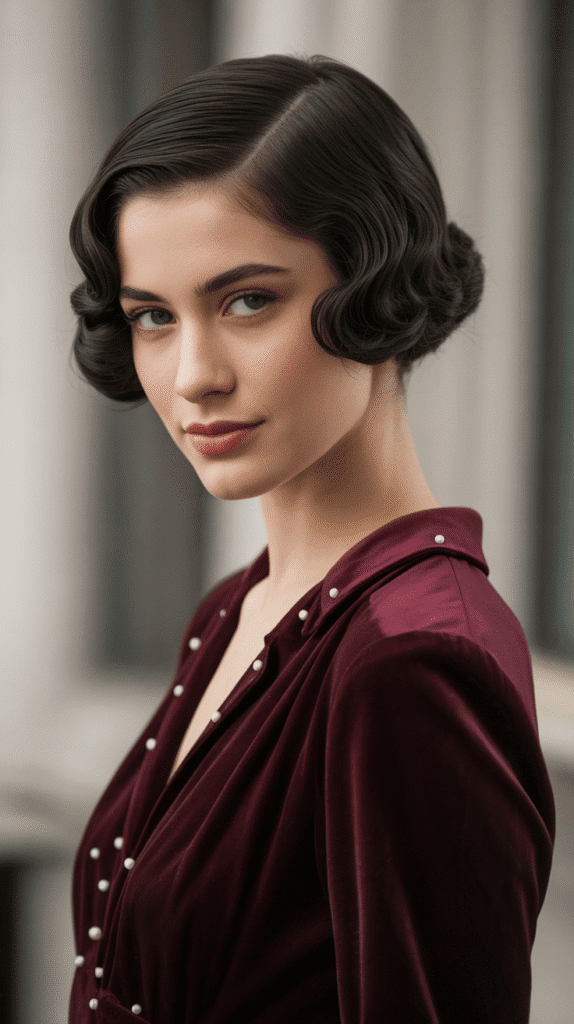
The pageboy emerged in the late 1930s as a softer alternative to the severe bobs of earlier in the decade.
This style featured hair turned under at the ends in a smooth, rounded roll that framed the face with gentle curves.
- The cut typically reached chin to shoulder length, with all hair cut to one uniform length to create the characteristic flip.
- Achieving the perfect pageboy required setting hair on large rollers positioned underneath, rolling toward the nape rather than away from the face.
- This style particularly suited round and square face shapes, as the inward curve softened angular features and added length to rounder faces.
- Bangs were optional but when included were typically styled straight across the forehead or swept slightly to one side.
- The pageboy required less frequent resetting than finger waves, usually maintaining its shape for several days with proper nighttime wrapping.
- This transitional style bridged the gap between 1930s waves and the smoother, longer styles that would dominate the 1940s.
7. The Pin Curl Set
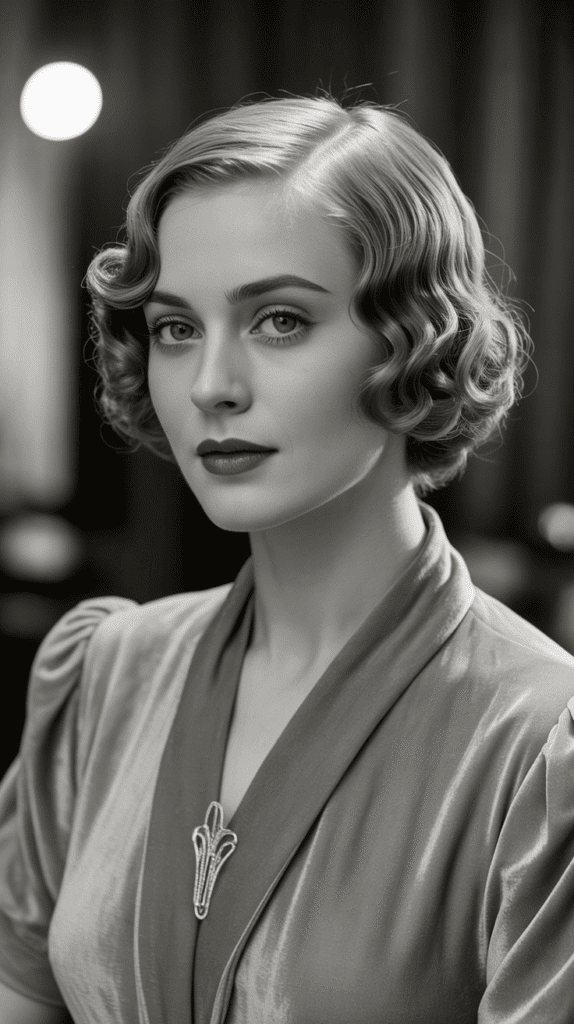
Pin curl sets formed the foundation of most 1930s hairstyles, serving as the nighttime preparation method for daytime glamour.
The size, direction, and placement of these curls determined the final style’s character.
- Individual sections of damp hair were wrapped around fingers to form flat circles, then secured against the scalp with crossed bobby pins or metal clips.
- Curl direction alternated in systematic patterns to create specific wave formations or overall volume and movement.
- Smaller pin curls produced tighter waves and more texture, while larger curls created softer, more open wave patterns.
- The setting process took 30-45 minutes, and hair needed to dry completely (6-8 hours) before removal to ensure lasting results.
- Sleeping in pin curls required covering the head with a silk scarf or net to prevent pins from catching on pillows and disrupting the set.
- After removing pins, hair was gently brushed and shaped into the desired style, with finger waves and Marcel waves often created from strategic pin curl placement.
8. The Asymmetrical Bob
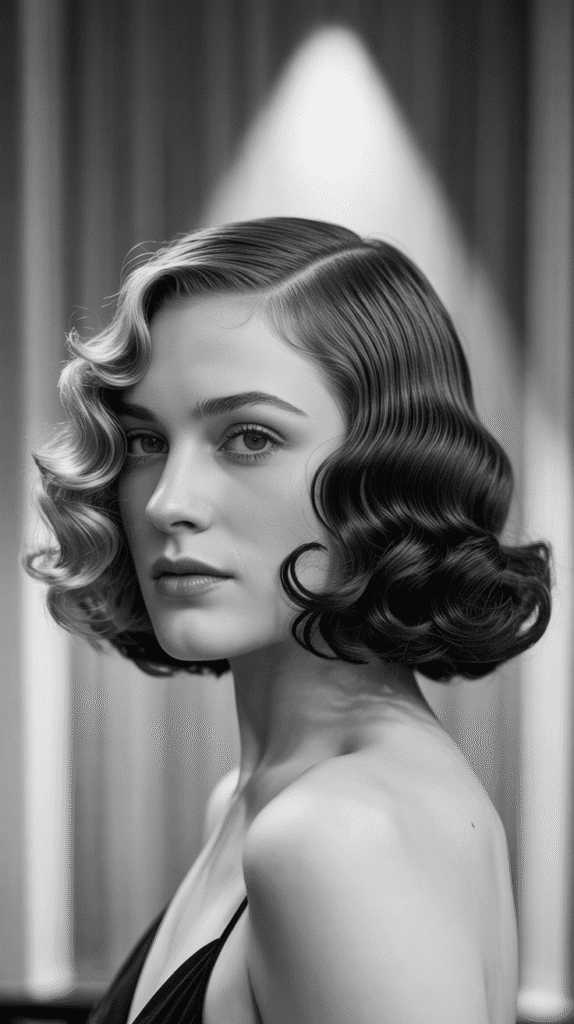
Asymmetrical bobs introduced dynamic visual interest by cutting one side longer than the other, creating a diagonal line from the shorter side to the longer side.
This avant-garde style appealed to artistic and fashion-forward women.
- The length difference typically ranged from one to three inches, with the shorter side often cut above the ear and the longer side reaching chin length or beyond.
- Deep side parts emphasized the asymmetry, with the longer section swept dramatically across the forehead or face.
- This style worked exceptionally well with finger waves or Marcel waves, as the diagonal line accentuated the wave patterns’ flow.
- Face-framing was the key advantage, as the longer side could be positioned to minimize prominent features or broaden narrow faces.
- Styling required careful attention to balance, ensuring the asymmetry appeared intentional rather than like a cutting mistake.
- Modern versions often incorporate color blocking or undercuts to enhance the asymmetrical element beyond just length variation.
9. The Water Wave
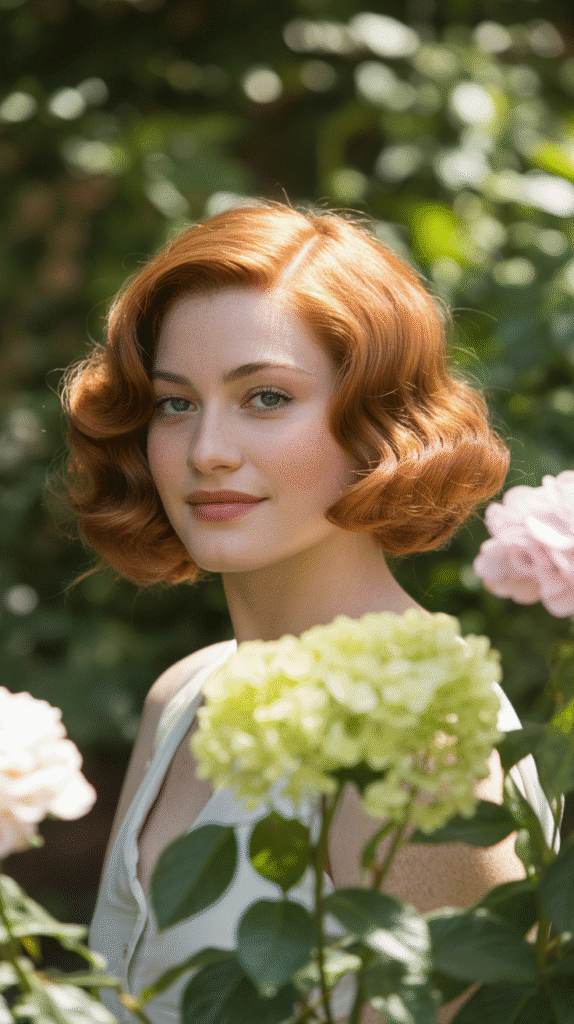
Water waves created softer, more natural-looking waves than structured finger waves, achieved by combing wet hair into gentle S-curves without the defined ridges.
This technique suited women seeking a less formal, more romantic appearance.
- Hair was sectioned while soaking wet and combed into shallow wave patterns using a wide-tooth comb.
- Each wave section was secured with large wave clips or crossed bobby pins positioned along the peaks and valleys of the wave.
- The result appeared more flowing and less geometric than finger waves, with waves that moved more freely.
- This method worked particularly well on naturally wavy hair, enhancing rather than fighting the hair’s natural tendency.
- Drying time was extended compared to straight styles, often requiring overnight setting or several hours under a hood dryer.
10. The Faux Bob
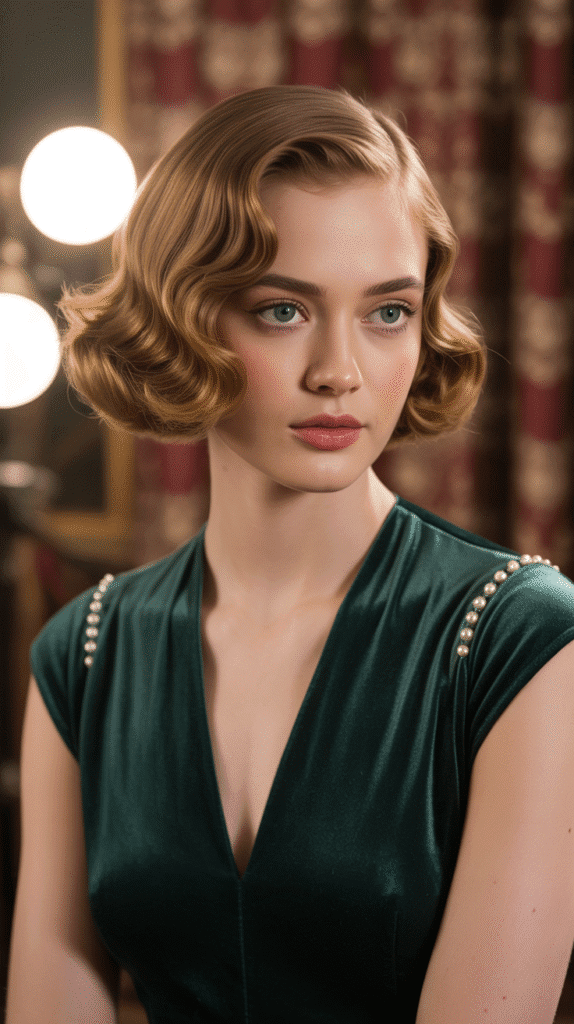
The faux bob allowed women with longer hair to participate in the short hair trend without committing to cutting their locks.
This ingenious styling technique created the illusion of a bob through strategic pinning and tucking.
- Longer hair was sectioned at the nape, with the length folded up and secured underneath the upper hair with pins, creating a false hemline.
- The visible upper section was then styled into waves or curls that appeared to end at chin or ear length.
- Small decorative combs, barrettes, or coordinating ribbons often concealed the pinning line where hair folded under.
- This versatile approach allowed women to switch between short and long styles depending on the occasion or their mood.
- Creating a convincing faux bob required sufficient density and length, typically at least shoulder-length or longer hair.
- The style offered the aesthetic of fashionable short hair while preserving length for women who needed it for religious, cultural, or professional reasons.
11. The Slicked-Back Shingle
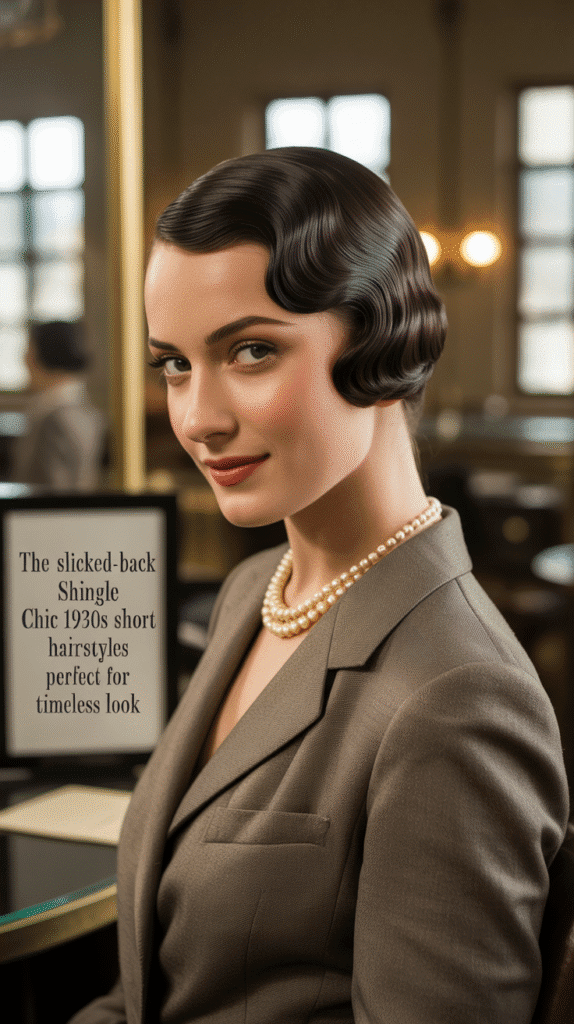
The slicked-back shingle combined the precision of the shingle cut with the high-gloss, sleek styling popular in the 1930s.
This ultra-polished look epitomized sophisticated urban style and evening glamour.
- Heavy pomade, brilliantine, or hair oil was applied generously to create a wet-look finish with mirror-like shine.
- Hair was combed straight back from the hairline, with every strand lying flat and smooth against the skull.
- The graduated back of the shingle cut created a sleek taper that emphasized the neck’s elegant lines.
- This style particularly suited formal evening occasions, often paired with drop earrings and bare-shoulder gowns to showcase the exposed neck.
- Small decorative elements like jeweled hairpins or art deco hair combs were positioned at the sides or back for added sophistication.
- The extreme sleekness required daily washing and restyling, as the heavy products attracted dust and lost their shine quickly.
12. The Side-Swept Wave
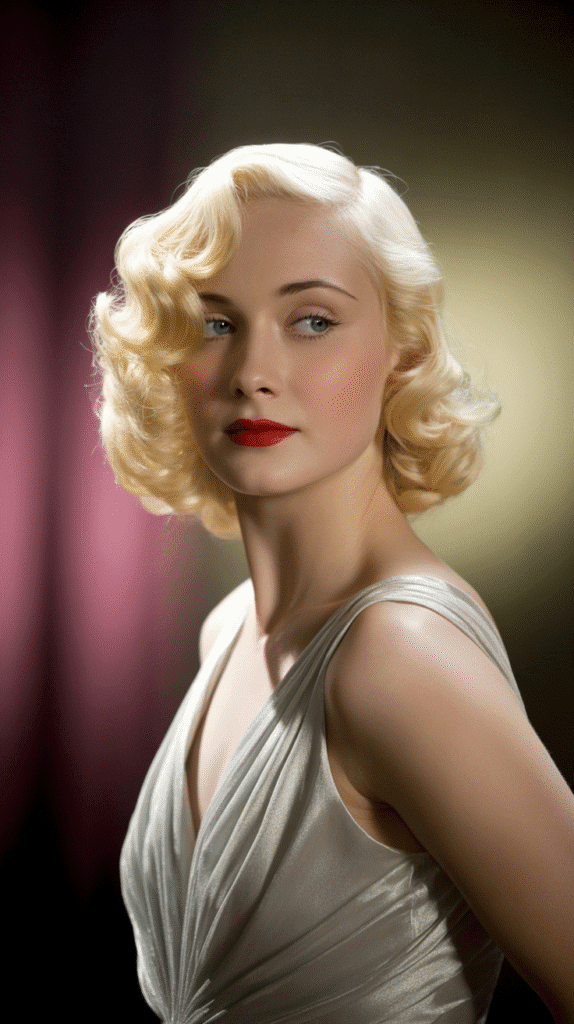
The side-swept wave featured all hair styled to one side in flowing waves that cascaded over one shoulder or framed one side of the face.
This dramatic asymmetry created Hollywood-worthy glamour and romance.
- An extreme side part positioned almost at the ear created the foundation for this style’s dramatic sweep.
- Large, flowing Marcel or finger waves were directed across the head from the part to the opposite side.
- The heavier side could be pinned behind the ear or left loose to drape across the shoulder for evening looks.
- This style created asymmetrical balance that worked particularly well for photography and film, as it provided interesting angles and dimension.
- One side of the face remained completely exposed, making this style ideal for showcasing statement earrings or makeup.
- The undulating wave pattern required expert placement to maintain structure while appearing naturally flowing rather than rigid.
13. The Curled Fringe Bob
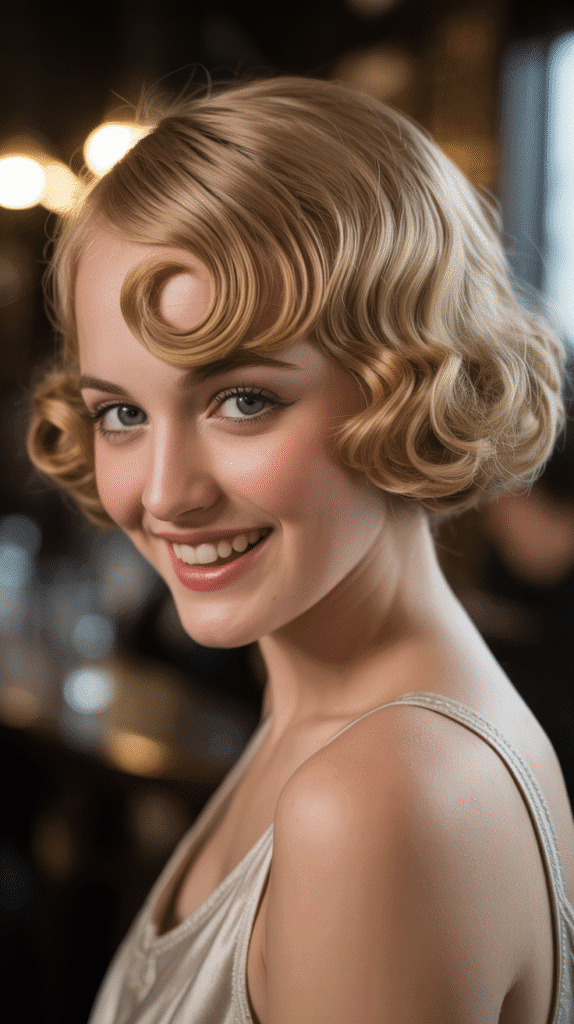
The curled fringe bob featured a short bob cut adorned with a row of small, tight curls across the forehead.
This playful style added youthful charm and vintage character to the classic bob silhouette.
- The fringe section was typically 1-2 inches deep, separated from the rest of the hair by a horizontal part.
- Small sections of fringe hair were wrapped around slim curling rods or the stylist’s fingers to create pin curls that dried into tight ringlets.
- The remaining hair could be styled smooth, waved, or curled depending on the desired level of formality.
- This style worked particularly well on shorter foreheads, adding visual height while maintaining the proportional balance of the face.
- Curls were usually directed to lie flat against the forehead rather than standing out, creating a decorative border effect.
- Evening variations featured more elaborate curl patterns, sometimes arranged in heart shapes or geometric designs across the forehead.
14. The Gibson Roll Variation
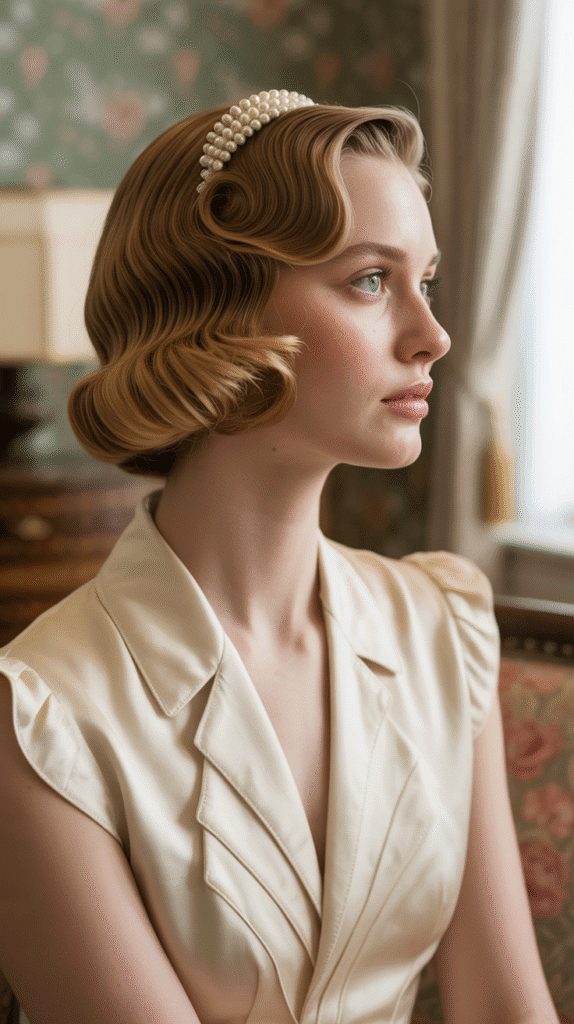
The Gibson roll, traditionally a longer hairstyle, was adapted for 1930s short hair by creating a similar rolled effect at the nape using the available length.
This style bridged vintage Edwardian elegance with modern 1930s sensibility.
- Hair at the back was rolled inward and upward, secured with pins to create a horizontal cylindrical shape at the nape.
- The top and sides featured typical 1930s waves or smooth styling that contrasted with the textured roll.
- This style required at least 4-6 inches of length at the back, making it suitable for longer bobs but not very short cuts.
- Padding or “rats” (mesh hair forms) could be inserted inside the roll to create fuller, more prominent rolls with less hair length.
- The style evoked romantic, classical beauty and was popular for weddings, formal events, and daytime social occasions.
- Hair combs decorated with rhinestones or pearls were often positioned above or within the roll for ornamental elegance.
15. The Graduated Layer Bob
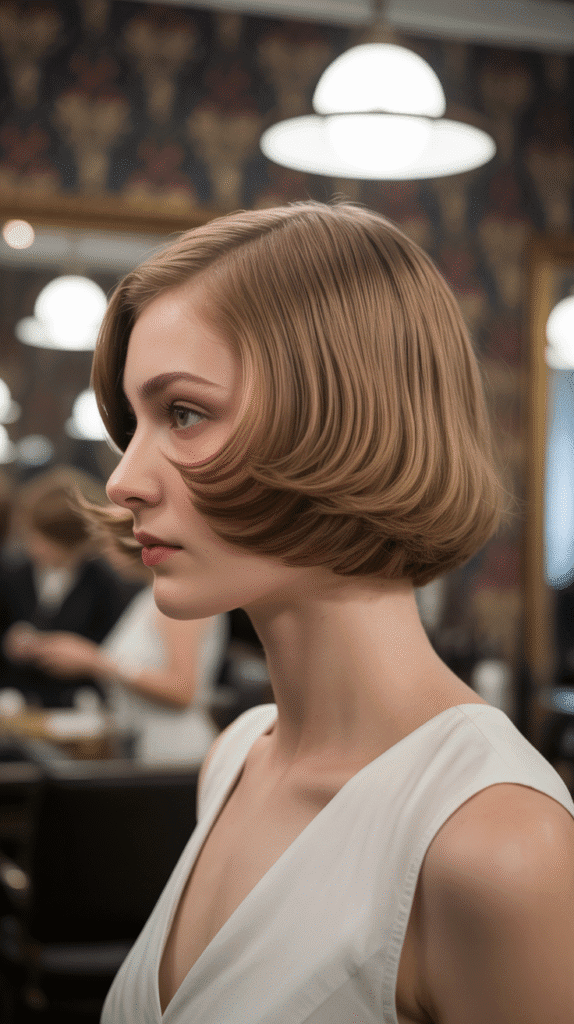
The graduated layer bob featured varying lengths throughout the cut, with shorter layers at the crown creating volume and longer layers underneath providing structure.
This dimensional cutting technique added movement and modern styling flexibility.
- Interior layers were cut progressively shorter toward the crown, creating stacked volume that lifted the silhouette.
- The perimeter length remained consistent, typically at ear or chin level, maintaining the classic bob outline.
- This cut worked exceptionally well with natural wave patterns, as different layer lengths created varied curl patterns that added texture.
- Styling options expanded significantly with layering, allowing for both smooth, sleek looks and textured, voluminous styles from the same cut.
- The layers required skilled cutting technique to blend seamlessly without creating obvious steps or disconnection.
- This approach influenced modern layered bobs and demonstrated that 1930s hairstyling encompassed sophisticated cutting techniques beyond simple blunt lines.
16. The Deep Wave Bob
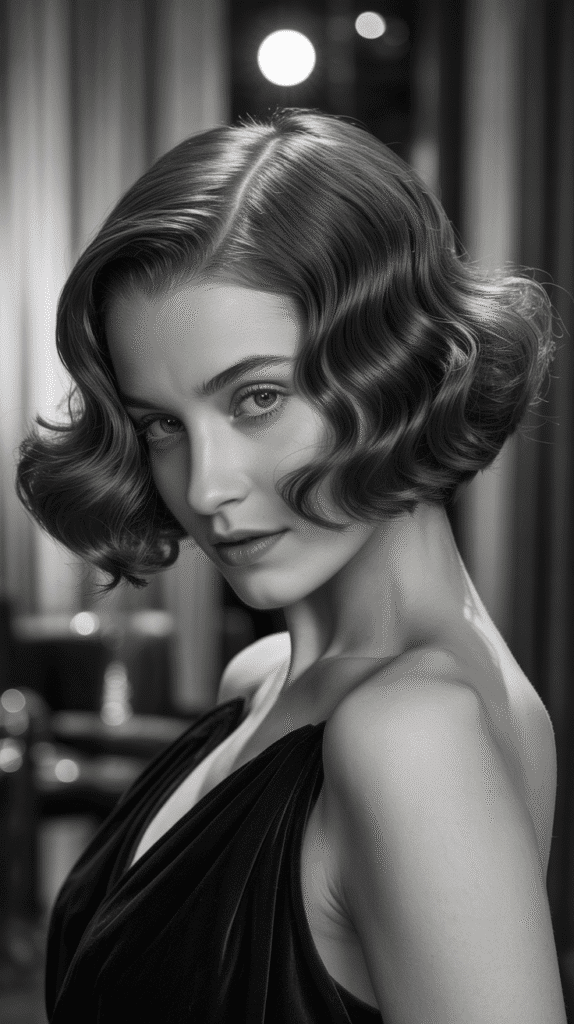
The deep wave bob featured exaggerated, wide waves with significant depth between peaks and valleys, creating dramatic undulation and sculptural quality.
This bold style made a strong fashion statement.
- Each wave measured 2-3 inches from peak to valley, creating pronounced S-curves that caught light and shadow dramatically.
- Setting these waves required large barrel curling irons or oversized pin curls arranged in alternating directions.
- The depth of the waves added horizontal volume, making this style particularly flattering for long, narrow face shapes.
- Strong setting products were essential to maintain the deep wave pattern against gravity and environmental factors.
- This style appeared most authentic when waves flowed horizontally around the head rather than vertically down from the crown.
- Deep waves created a sense of luxury and special-occasion glamour, often reserved for evening events and formal photography.
17. The Brush-Out Wave
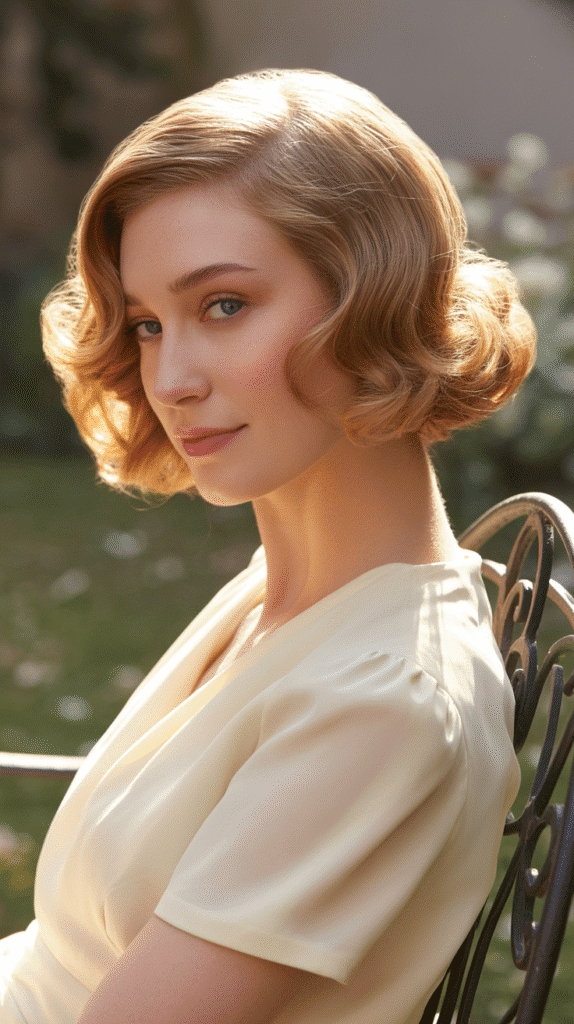
The brush-out wave represented a softer, more casual interpretation of formal finger waves, achieved by setting hair in waves and then brushing through them to create diffused, romantic texture.
This style suited daytime wear and less formal occasions.
- Hair was first set into finger waves or Marcel waves using traditional techniques and allowed to dry completely.
- Instead of leaving the waves crisp and defined, they were gently brushed through with a soft-bristle brush.
- The result was soft, flowing hair with gentle undulation rather than sharp, geometric wave patterns.
- This technique created volume and body while maintaining the 1930s aesthetic in a more relaxed, wearable form.
- The brushed-out style appeared more natural and suited casual social activities, shopping, or daytime entertaining.
- Less setting product was visible in the finished style, and hair moved more freely with a silkier texture than heavily set waves.
18. The Peek-a-Boo Bob
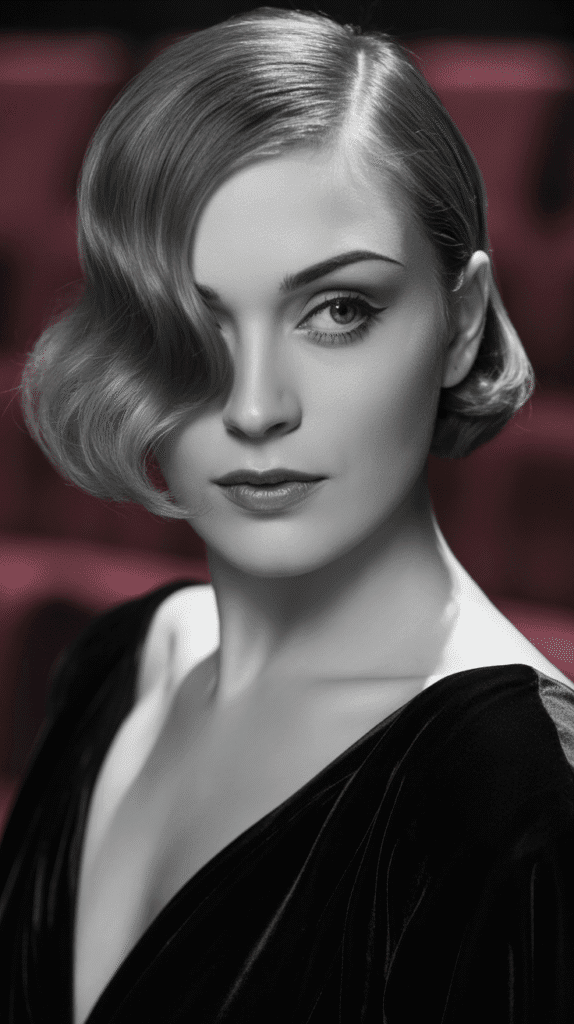
The peek-a-boo bob featured a longer section of hair artfully positioned to fall across one eye, creating mysterious allure and sophisticated drama.
This style became iconic through Hollywood screen sirens of the era.
- One side was cut or styled significantly longer than the other, with the extended section swept forward across the cheekbone and eye.
- The dramatic eye-covering element created intrigue and drew attention to facial features in photographs and on screen.
- The covered eye technique required careful positioning to appear seductive rather than messy or accidental.
- Most women could only maintain this dramatic styling for special occasions, as functioning with obscured vision proved impractical for daily life.
- The longer section often featured specific wave patterns or curls that maintained its position across the face.
- This style influenced later decades’ hair trends, particularly the 1940s Veronica Lake wave that fully developed this peek-a-boo concept.
19. The Feathered Ends Bob
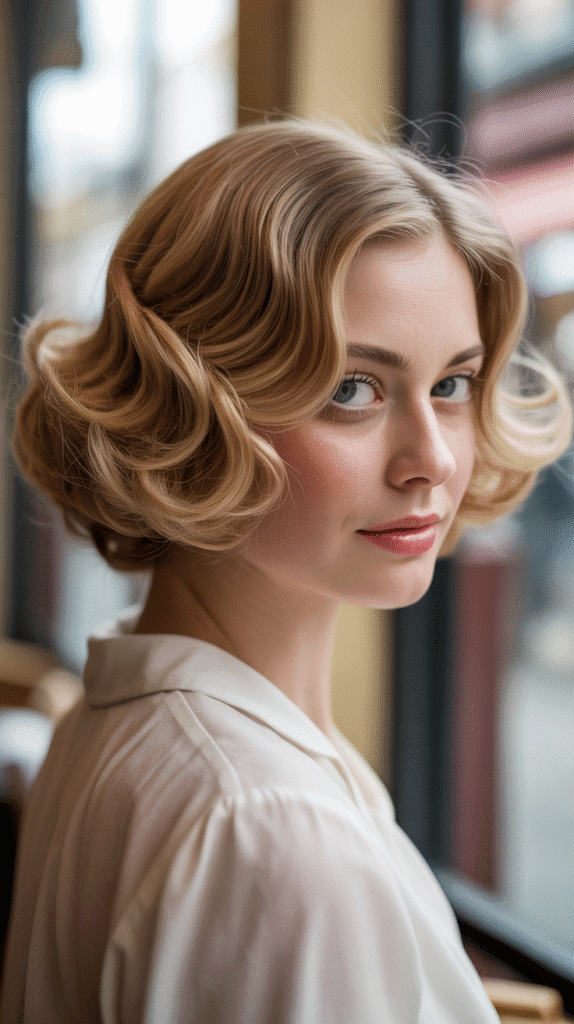
The feathered ends bob incorporated texturizing techniques at the hair ends, creating soft, wispy tips that added movement and lightness to the classic bob structure.
This subtle variation prevented blunt bobs from appearing too heavy or severe.
- Scissors or razors were used to thin and taper the hair ends, removing weight and creating feathered texture.
- The feathering technique worked particularly well on thick, coarse hair that otherwise appeared too bulky in a bob cut.
- Ends could be styled to flip outward slightly, inward, or left to lie naturally depending on the desired effect and face shape.
- This approach created a softer perimeter that moved more naturally and required less rigid styling than blunt-cut bobs.
- The feathered texture caught light differently than blunt ends, adding dimensional interest and preventing a one-dimensional appearance.
- Modern point-cutting and razor techniques derive from these early feathering methods developed in the 1930s.
20. The Victory Roll Foundation
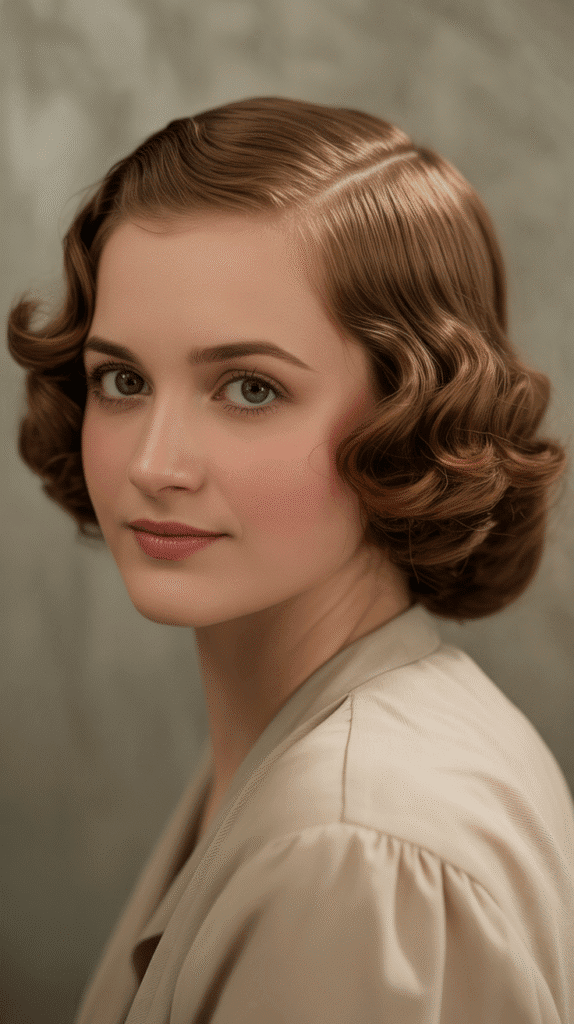
While victory rolls became most popular in the 1940s, their foundation was established in late 1930s styling experiments with rolled sections of hair.
These early iterations featured smaller, more subtle rolls incorporated into waved hairstyles.
- Small sections of hair at the front hairline were rolled backward and upward, creating cylindrical shapes that added height and vintage character.
- The rolls were typically narrower and less voluminous than their 1940s successors, integrated more subtly into the overall wave pattern.
- One or two small rolls positioned symmetrically or asymmetrically at the front temples created vintage charm without overwhelming the style.
- This technique worked particularly well on bob-length hair, using the available length to create petite rolls that complemented rather than dominated.
- The rolls were secured with crossed bobby pins and often required setting lotion or light pomade to maintain their shape.
- These early experiments demonstrated how hairstyling evolved progressively, with one era’s innovations building on the previous decade’s techniques.
21. The Coronet Braid Bob
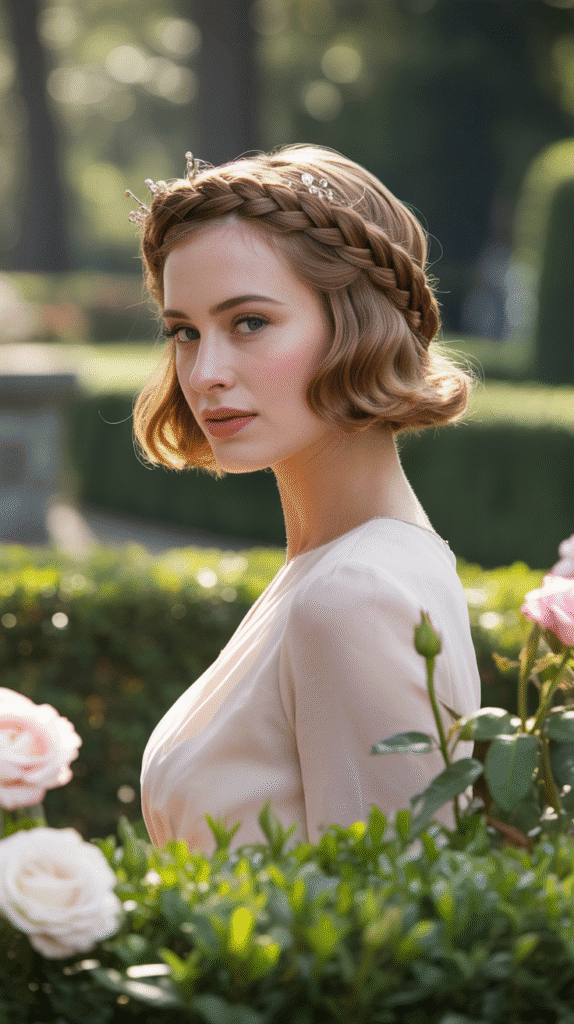
The coronet braid bob created the illusion of a braided crown around the head using shorter bob-length hair.
This style required clever pinning and positioning to achieve the coronet effect with limited length.
- Hair was deeply side-parted, with the larger section swept across the crown and arranged to simulate a braid’s appearance.
- Small sections were twisted and pinned to create texture that resembled braided strands even when actual braiding was impossible with short length.
- The style worked best on hair at least chin-length, providing enough length to manipulate around the crown area.
- Decorative elements like small flowers, jeweled pins, or ribbon often enhanced the coronet effect and disguised pins.
- This romantic style suited garden parties, afternoon teas, and other genteel social occasions popular in the 1930s.
- The coronet created height at the crown, elongating the face and creating a regal, classical appearance.
22. The Cloche-Friendly Bob
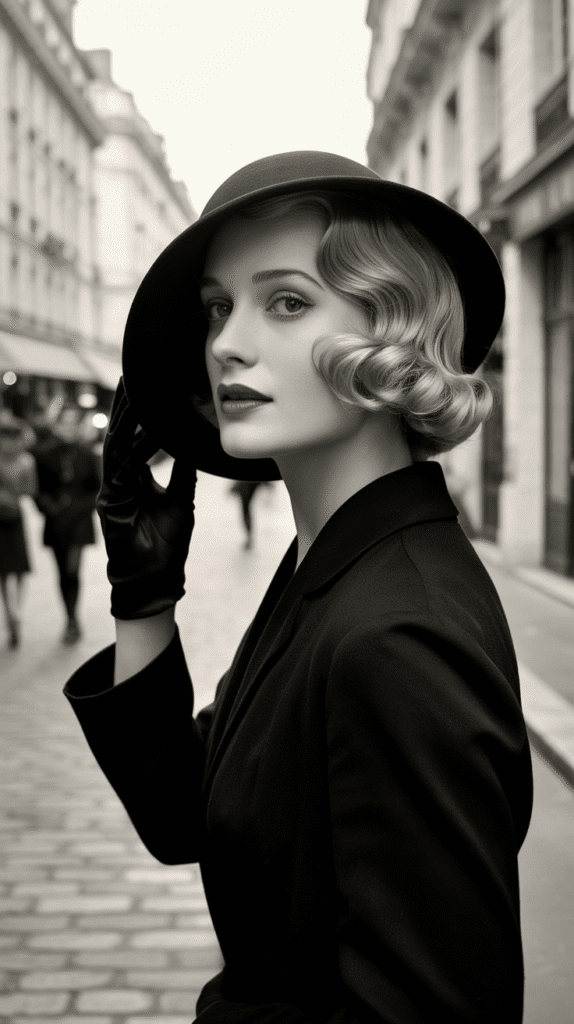
The cloche-friendly bob was specifically cut and styled to complement the cloche hats that dominated 1930s fashion.
This practical style remained neat and attractive when revealed after removing the signature close-fitting hat.
- Hair was cut shorter at the sides and back to fit completely under the cloche without creating bulk or distortion.
- The front section could be slightly longer, styled into small waves or curls that peeked out from under the hat’s brim.
- Smooth, flat styling was essential, as volume or height would prevent the cloche from sitting properly on the head.
- When the hat was removed, the hair revealed neat waves or sleek styling that required minimal adjustment or touch-up.
- This practical consideration influenced cutting and styling choices for fashionable women who wore hats daily.
- The style demonstrated how 1930s hairstyling responded to fashion accessories and incorporated them into the overall design philosophy.
23. The Sculptured Wave Bob
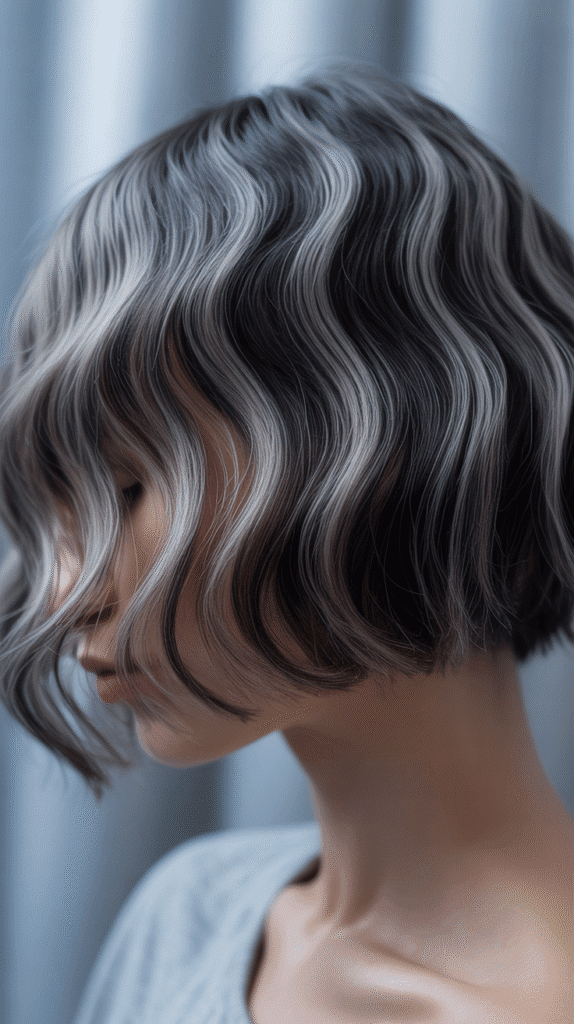
The sculptured wave bob treated hair as a three-dimensional medium, creating waves that appeared carved or molded with architectural precision.
This artistic approach elevated functional styling into aesthetic expression.
- Waves were positioned with mathematical precision, each curve calculated to create specific angles and shadows.
- The sculptural quality required expert technical skill, with stylists using multiple setting techniques simultaneously to achieve the desired effect.
- Light and shadow played across the precisely positioned waves, creating dramatic visual interest from multiple viewing angles.
- This style represented hairdressing as an art form, with individual stylists developing signature techniques and patterns.
- Competition hairstyling and salon display work often featured exaggerated versions of sculptured waves showcasing technical mastery.
- The precision required meant this style was typically created for special occasions, photoshoots, or fashion presentations rather than daily wear.
24. The Natural Texture Bob
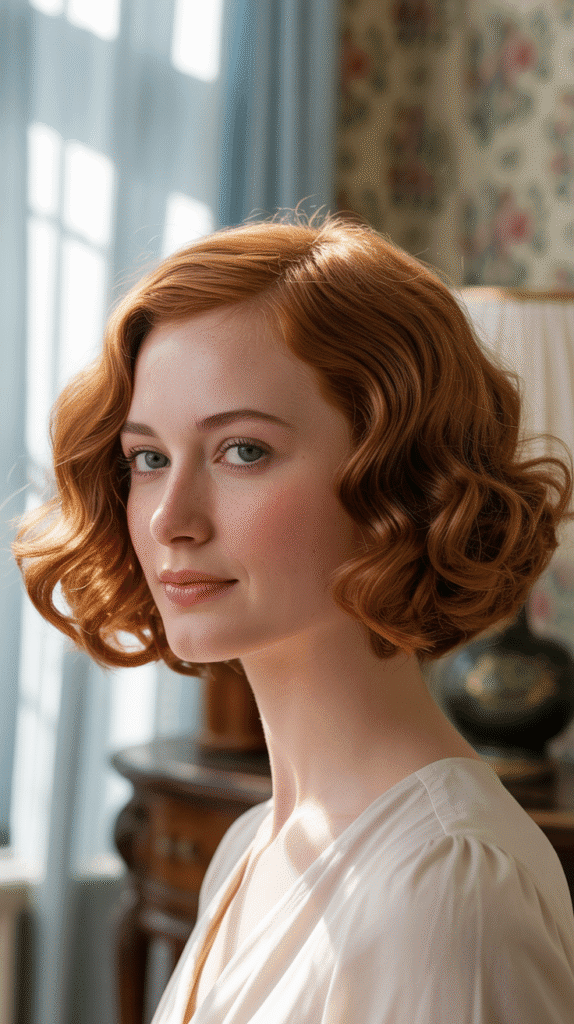
The natural texture bob celebrated inherent hair characteristics rather than fighting them, allowing natural wave patterns, curl tendencies, and texture to inform the styling approach.
This progressive concept respected individual hair qualities.
- Cuts were customized to work with rather than against natural hair patterns, accommodating cowlicks, growth patterns, and curl formations.
- Minimal heat styling and setting allowed hair to express its natural texture within the bob structure.
- This approach proved particularly beneficial for women with thick, coarse, or curly hair who struggled with heavily manipulated styles.
- Products focused on moisture and definition rather than strong hold, creating softer, more touchable results.
- The natural texture philosophy represented early understanding of hair health and the benefits of working with rather than against natural characteristics.
- This style required less daily maintenance than set styles, though it didn’t always achieve the polished perfection of formal 1930s aesthetics.
25. The Tapered Nape Bob
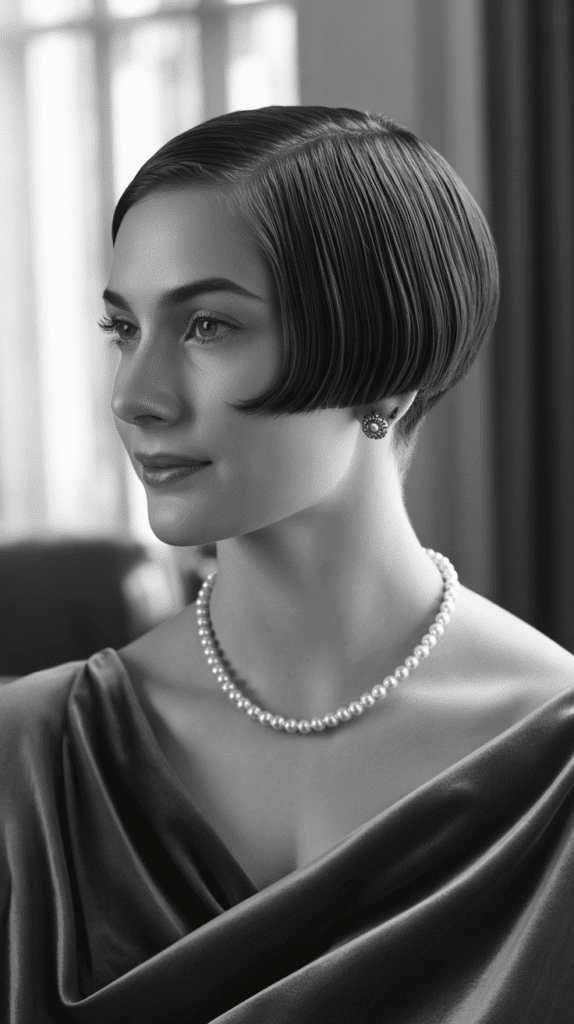
The tapered nape bob featured graduated length from crown to nape, creating a sleek, elongated line at the back of the head.
This technical cutting approach balanced proportion and created refined elegance.
- Hair gradually shortened from approximately 4-6 inches at the crown to barely 1-2 inches at the nape hairline.
- The tapering was visible from the profile view, creating a diagonal line that emphasized neck length and posture.
- This cut required regular maintenance as the shortest sections grew quickly and disrupted the intended proportions.
- The style worked exceptionally well for thick hair, removing bulk at the nape while preserving volume at the crown.
- Styling versatility was a key advantage, with the longer crown sections allowing for various wave patterns and curl styles.
- The clean lines of the tapered nape created a professional, polished appearance suitable for both professional and social contexts.
26. The Crimped Wave Bob
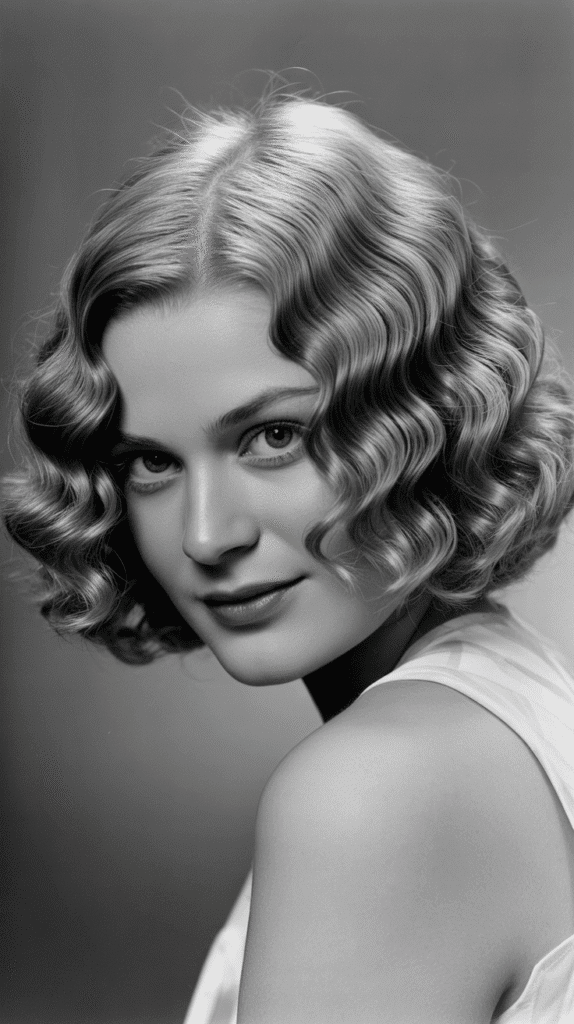
The crimped wave bob featured tightly waved or crimped texture throughout, creating uniform zigzag patterns rather than smooth S-curves.
This textured approach added volume and distinctive character to the bob silhouette.
- Crimping was achieved using specialized crimping irons with corrugated plates that pressed zigzag patterns into the hair.
- The resulting texture was more three-dimensional than flat finger waves, creating all-over volume and body.
- This style worked particularly well on fine, thin hair that lacked natural volume, as the crimped texture created the illusion of density.
- The uniform texture caught light from multiple angles, creating shimmer and movement throughout the hairstyle.
- Maintenance required complete resetting every few days, as sleeping and daily activities disrupted the precise crimped pattern.
- The crimped bob represented a more playful, textured alternative to the sleek sophistication of smooth wave patterns.
27. The Evening Glamour Bob
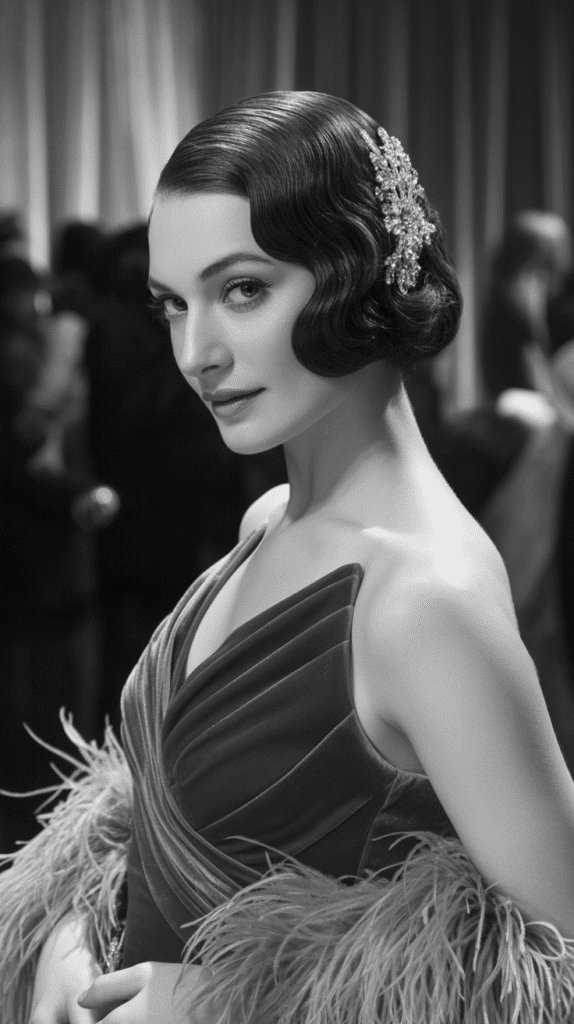
The evening glamour bob represented the pinnacle of 1930s hairstyling artistry, combining multiple techniques into elaborate styles reserved for formal occasions, galas, and special events.
This style showcased technical mastery and creative expression.
- Multiple wave patterns, curl types, and sculpting techniques were combined into cohesive, elaborate designs.
- Decorative elements including jeweled combs, feathers, flowers, and art deco ornaments were strategically positioned for maximum impact.
- The styling process could take several hours, often performed in salons on the day of the event.
- High-shine products created glamorous, polished surfaces that photographed beautifully and caught candlelight at evening events.
- These styles demonstrated the hairstylist’s skill and the wearer’s commitment to fashion and social presentation.
- The evening glamour bob represented hairdressing at its most artistic, treating the head as a canvas for creative expression while maintaining the era’s aesthetic principles.
Styling Tips for Modern Wearers
If you’re inspired to recreate these 27 Chic 1930s Short Hairstyles Perfect for Timeless Look today, understanding proper techniques and modern adaptations will help you achieve authentic results.
- Start with the right cut by showing your stylist reference images and ensuring they understand vintage proportions and graduation.
- Invest in quality styling tools including a Marcel iron or flat iron for creating authentic wave patterns, and metal wave clips for setting.
- Use modern setting products that provide hold without the stiffness of vintage formulas, such as flexible mousse or setting spray.
- Practice creates perfection with finger waves, so expect your first attempts to be imperfect and improve with repetition.
- Protect your hair by using heat protectant products before applying hot tools, and deep condition regularly to prevent damage from frequent styling.
- Consider temporary options like wigs or hairpieces for costume events or themed parties if you’re hesitant to commit to cutting your hair.
- Study vintage photographs and films to understand how these styles moved and looked from different angles, informing your styling approach.
- Adapt the styles to suit modern life by incorporating contemporary elements like balayage color, modern accessories, or hybrid cuts that blend vintage and current trends.
Conclusion
As we’ve explored these 27 Chic 1930s Short Hairstyles Perfect for Timeless Look, it becomes clear why this era’s hairstyling continues to captivate and inspire nearly a century later.
The 1930s represented a perfect convergence of technical innovation, artistic expression, and practical elegance that created truly timeless looks.
From the architectural precision of the shingle bob to the romantic softness of water waves, each style tells a story of women who embraced modernity while creating new standards of beauty and sophistication.
Whether you’re drawn to the sleek glamour of Marcel waves, the bold statement of an Eton crop, or the versatile charm of a pageboy cut, these vintage styles offer endless inspiration for contemporary interpretations.
The techniques developed during this golden age of hairstyling laid the foundation for modern cutting and styling methods, proving that true innovation creates lasting impact. As you consider which of these twenty-seven styles speaks to